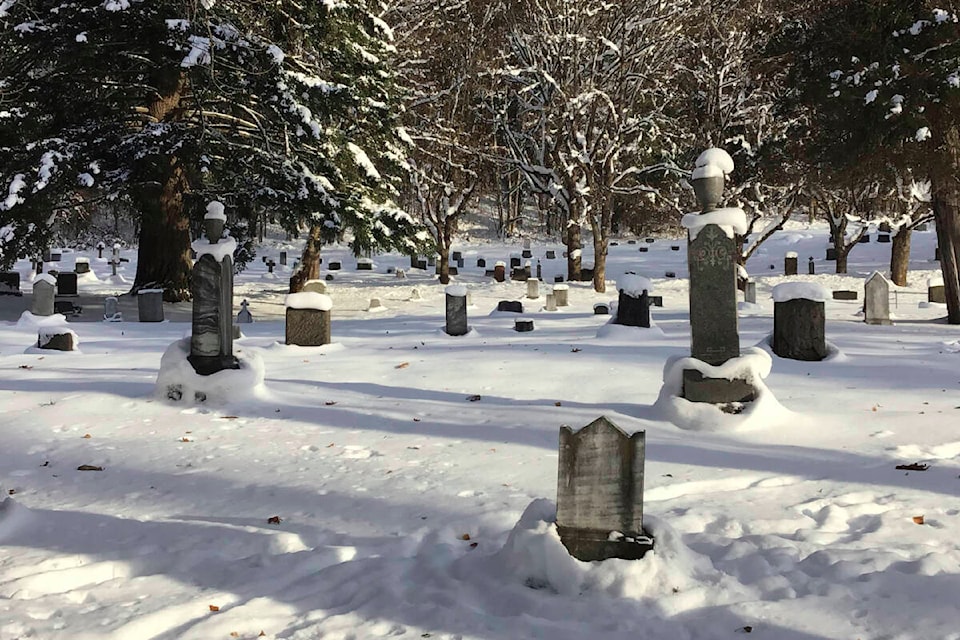by Donna Macdonald
It’s odd to think Nelson has a necropolis. That word evokes ancient times and places, like the Giza Necropolis in Egypt, and yet it simply means an elaborate and planned burial place. While we may not equal Giza, our Nelson Memorial Park (a.k.a the cemetery) is a necropolis all the same.
Beginning at the gate, the tree-lined road weaves back-and-forth across the slope through green expanses dotted with sculpted and carved remembrances of lives lived. Some markers are modest or hand-crafted, made locally; larger statues were often shipped from Italy. Mature trees stretch out their branches to provide shade, grace and colour to the landscape. It’s simply a beautiful place.
In 1898, the city bought 16 hectares of land from CPR for a permanent cemetery, just south of town. As was the custom, a third of the land was surveyed into sections, by religion (Anglican, Catholic), by ethnicity (Chinese) and by social organizations (Masons, Eagles, Odd Fellows). Soldiers also had a designated plot. The general or indigent plots were for the unaffiliated.
The next step was to exhume the bodies in the old burial ground near the current city campground and transport them in the horse-drawn Resurrection Wagon to the new cemetery. Those graves all pre-date 1899 and set the pattern of gravestones facing east so the deceased could watch the sun rise on Resurrection Day. Over time the cemetery’s population grew considerably, and for many years has exceeded the number of living Nelsonites.
People have strongly held ideas about what is appropriate activity in a cemetery. The 1903 City bylaw, for example, banned bicycles and tricycles, and horses moving faster than a walk. No picnics, no smoking and no dogs!
More recently, the building of the crematorium and the proposal for a disc golf course in the forest above the cemetery caused impassioned debates about how we respect and honour the dead. Last week as I walked the snowy road, I also remembered the Columbian ground squirrels controversy. Early in my political career, if you remember from a previous column, I was the Goose Trustee. I moved on from that to the Squirrel Saver. Or I tried.
The squirrels (often mistakenly called gophers) had prompted complaints from the public. The squirrels are very cute as they sit up with their forefeet folded tidily in front of them, peering about. But they also dig extensive underground networks of tunnels and some people felt this wasn’t appropriate near their loved ones’ graves.
Once again the community debate arose: kill the critters or find another solution? Live trapping was considered, as was attracting raptors or planting euphorbia whose stinky roots repel underground creatures. Then, abruptly, the complaints stopped. Was it because the squirrels, which hibernate 70 per cent of the year, had gone underground? No.
One day I was in the mayor’s office and he blushingly confessed that he’d ordered the squirrels to be poisoned. A tender-hearted man, he said he couldn’t withstand the tearful pleas of the people coming to his office so upset about the squirrels’ activities. He was sorry, he said, but what could he do?
Well, I had a few thoughts on that, but what could I say? The deed was done. Over the years since then, I must say I haven’t noticed many squirrels at the cemetery. I haven’t asked why.
For many people, the Memorial Park is a welcoming place for a stroll, a bike ride, a stroller push, a dog walk (on leash). Even a bit of sledding. The park offers remembrance and honouring, and also allows quiet enjoyment of the natural and built beauty of our mountain-side necropolis.
It’s a favourite walk for me on Christmas Day, a chance to greet family members buried there and also neighbours and friends. Maybe I’ll see you there. If not, I wish you a warm and joyful holiday season.
Donna Macdonald has lived in Nelson since 1972, and is the author of Surviving City Hall, a memoir of her 19 years on Nelson City Council. Her column appears monthly. Credit goes to Alistair Fraser and the late Ron Welwood for information used in this column.
